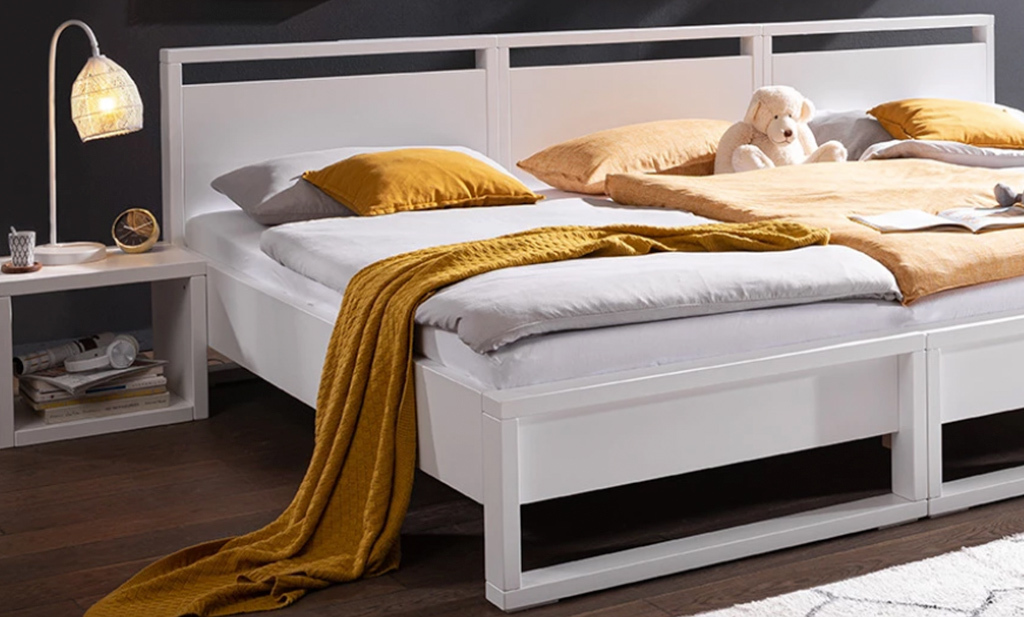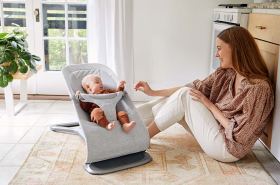
Should you co-sleep with your baby?
Sleeping close to your little one seems innocent enough. After all, what’s sweeter than cuddling up all night with your baby? But co-sleeping and bed-sharing have become heated topics, and with so many opinions on either side, it can be hard to figure out the healthiest choice for your family. Our midwife Katrin Ritter tells you all the things you need to know about co-sleeping to make the best decision for you and your family.
What is co-sleeping or bed sharing?
Co-sleeping means that parents and children sleep in the same bed or in the same room. There are different types of co-sleeping:
– Room-sharing: Your baby or child sleeps in their own bed or in a cot in the same room as you. For the first six months your baby should be in the same room as you when they’re asleep, both day and night.
– Bed-sharing: Your baby or child sleeps in the same bed as you.
– Side sleeping: Your child sleeps in a cot attached to your bed so that they can sleep next to you.
What if I’m not planning to co-sleep?
Many parents find themselves co-sleeping at some point whether they plan to or not so wherever you’re planning for your baby to sleep it’s worth making your bed a safer place for your baby.
Co-sleeping more safely: positions and tips.
The sleeping environment for babies in the family bed should, as in their cot – follow all safe sleep guidelines to minimise the risk of sudden infant death syndrome (SIDS).
Whether you choose to co-sleep, or it is unplanned, there are some key points to consider.
1) Always place your baby in the supine position (on their backs) for sleep. Once they can roll independently from both front to back and back to front you don’t have to turn them back over if they roll to their side or front themselves.
2) Babies should be laid to sleep on a firm, flat mattress for support – never soft.
3) Keep pillows and adult bedding away from your baby or any other items that could cover their head or cause them to overheat. A high proportion of babies who die as a result of SIDS are found with their head covered by loose bedding. The Lullaby Trust.
4) Don’t let baby get too hot or too cold. The ideal room temperature is between 16-20°C. Make sure their sleep clothing is appropriate for the ambient room temperature.
5) Baby can sleep in a hip healthy swaddler or sleeping bag in a suitable TOG which is appropriate for the room temperature. These are a particularly great choice when bed-sharing to keep little one at the right temperature without loose covers. Baby sleeping bags should be well fitted, so the baby can’t wriggle down inside.
6) To reduce the risk of accidents, do not bring other children or pets into bed with you.
7) Try to make sure or check that baby cannot be trapped, wedged or fall out of bed or get trapped between the mattress and the wall.
8) Never leave your baby unattended in an adult bed.
9) Do not co-sleep with your baby if you or anyone in the bed have drunk any alcohol, smoke, been taking drugs or medication that make you drowsy; these factors can put babies at an extremely high risk of SIDS when co-sleeping. One study found that the risk of SIDS when co-sleeping is six times higher in smokers than in non-smokers. The Lullaby Trust.
10) It’s important not to share a bed with your baby if they were born before 37weeks and/or had a low birthweight (less than 2.5kg or 5.5lb).
A side-sleeper cot or bassinet can be a great alternative if you don’t have enough space or cannot create a safe space for baby on your bed. If using a side sleeping cot then follow the guidelines above and make sure nothing else is in the crib – no toys, cot mobiles, blankets or crib bumpers, which all pose suffocation risks.
Co-sleeping or bed sharing with your baby: risks and benefits
Sometimes, it can seem easier to share a bed with your baby, particularly if you’re breast/chestfeeding, or if your baby struggles to settle without you. Many parents say that co-sleeping helps them to create a strong and loving bond with their baby too. But before you curl up with your baby, keep the safety tips in mind. Accidentally falling asleep while you’re feeding is easy to do, and if that happens when you’re on the sofa or in an armchair etc., your baby could come to harm. It’s better to plan for possible co-sleeping and make your bed safe than to accidentally fall asleep in this situation.
The most important advantages of co-sleeping or bed sharing, at a glance:
– Parents have an instinctual drive to stay close to their infant, and some parents believe that children derive a greater sense of security and well-being from sleeping near their parents. When parents and babies sleep together, their heart rates, brain waves, sleep states, oxygen levels, temperature, and breathing influence one another.
– From a practical standpoint, co-sleeping offers convenience. Not only does bed-sharing keep parents physically close by to respond to the baby’s needs at night, but the proximity can make it easier for the breast/chest feeding parent to nurse throughout the night with minimal interruption to their own sleep. And more sleep for you can only be a good thing!
– Lying next to your baby means that you’re likely to check on your little one more often through the night. So you may notice if they become unwell more quickly than if they were in a cot.
– Some studies have shown that babies/children who bedshared are more independent, self-reliant, and confident in their daily lives than children who did not bedshare.
The most important disadvantages, at a glance:
– Some babies are wriggly, kicky, noisy sleepers and that can take some getting used to.
– Children who bedshare do tend to transition to sleeping independently about a year later than other children.
– Bed-sharing with your baby may affect your sex life if you have a partner. But there are other ways (and places) to keep your sex life going and communicating with your partner is key.
Should I co- sleep with my newborn baby?
It is important to know there is no clear right or wrong. Every child is different. Every family is different. Some babies need more closeness and can hardly be put down, others lay relaxed in their side sleeping cot and sleep through the night from an early age. Your child’s sleeping behaviours and needs will change over time and it’s not always linear! For example, some children need a lot of closeness when they are sick or during big changes in their life, but otherwise want to sleep alone. So be open and try to adjust your situation accordingly if you notice that things are not going as you had imagined. And of course, make sure you follow safe sleep guidelines until baby is at least one year old. Because, whether co-sleeping or not – the important thing is that you and your child are safe and happy.



